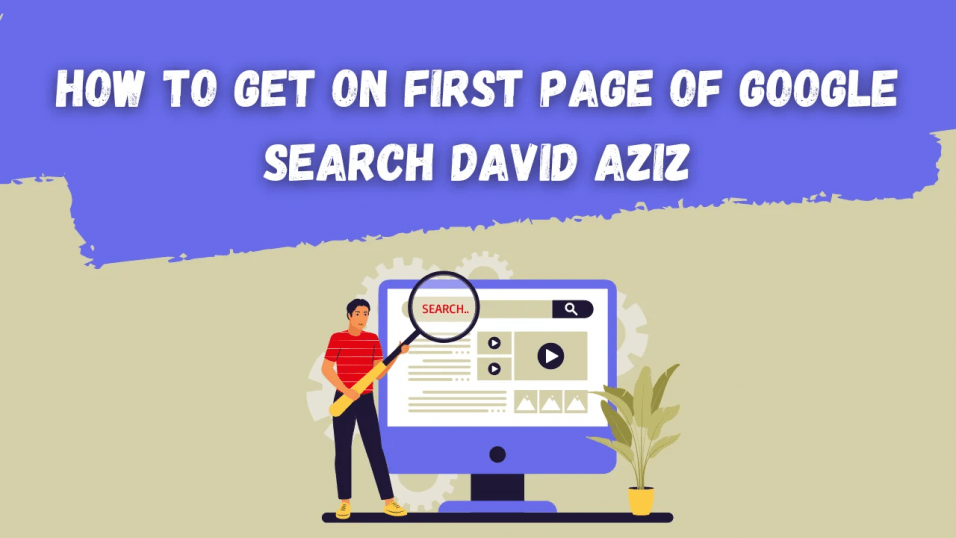
Overview
In today’s technology age, securing a spot in Google’s first page of search is paramount for companies, blog owners, and web content providers in an effort to maximize presence and access in cyberspace.
Referencing SEO expert David Aziz, in this article, we go in detail with techniques that will position your website high and make it a standout in a congested cyberspace.
Understanding Google’s algorithm mechanism
Google employs a complex algorithm that considers many factors in deciding web page ranking. Some of the most important factors include:
- Relevance: How closely your content aligns with the user’s search query.
- Authority: The believability and trust in your site
- User Experience (UX): Overall, your site’s usability and effectiveness for its visitors
By focusing on these fundamentals, one can develop a strong SEO campaign that complements Google’s ranking factors.
Comprehensive Keyword Research
Effective SEO begins with keyword analysis. Having an awareness of your target group’s keywords and phrases enables your content to respond to their search intention. Analyze with Google Keyword Planner, Ahrefs, and SEMrush for high search keywords and competitive but feasible competition.
Long-Tail Keywords
Emphasizing long-tail keywords, that is, keywords with a high level of detail, can pay off for you. Instead of a general keyword “digital marketing,” for instance, target “digital marketing strategies for small companies.” Long-tail keywords have less competition and attract focused searchers with a specific intention.
Financial Updates Aggr8finance
On-Page SEO, Optimizing Individual Pages
On-page SEO entails optimizing several factors in your web pages in an attempt to make them search-engine friendly.
Title Tags and Meta Tags
Craft compelling title tags with your key keywords and not exceeding 60 characters, and pair them with effective meta descriptions that best represent your page contents and compel visitors to click through
Header Tags and Organization of Content
Organize your site in a hierarchical format with header tags (H1, H2, H3, etc.) to make your site easier to navigate and for search engines to understand your site’s most important subjects.

Image Optimization
Ensure all your images have keyword-enriched file names and alt text with relevant keywords. Doing so not only helps with accessibility but also helps search engines understand them even better.
High-Quality Content
Content remains a driving force for SEO success. Google prefers information that is relevant, useful, and high-value for searchers’ queries.
Content Depth and Length
While there’s no single word count for best SEO, longer, high-value content will rank best overall. Write about your subjects in a full and expansive manner, providing useful information and actionable tips.
User Engagement
Encourage user activity through social shares, comments, and internal linking. Engaged visitors will spend more time on your site, minimizing your site’s bounce rate and sending a message to Google that your site contains valuable information.
Mobile Optimization
With a lot of web traffic being generated through mobile, having a website that is optimized for mobile use is important.
Responsive Design
Implement a responsive web design that works perfectly with any device and any screen resolution, offering a best-viewed-by-any-device reading experience.
Page Speed
Optimize your website loading speed with file compression, leveraging browser caching, and codes minimizing. Google PageSpeed can be used to scan for improvement sections.
Building High-Quality Backlinks
Backlinks from reputable websites serve as endorsements of your content’s quality and relevance.
Guest Blogging
Contribute articles to high-value websites in your niche to promote your work and obtain useful links.
Content Promotion
Create shareable assets such as infographics, in-depth guides, and custom studies, and promote them in a way that will generate organic backlinks.
User Experience (UX)
A positive visitor experience keeps visitors lingering and discovering additional parts of your site
Intuitive Navigation
Design a simple and logical site map that will allow information to be found with ease
Readability
Use concise paragraphs, bullet points, and graphical aids to make your information accessible and digestible
Local SEO
For businesses with a specific target region, location SEO is paramount.

Google My Business
Claim and authenticate your Google My Business listing, and update your business information to make it current and correct.
Local Citations and Reviews
Maintain consistent and updated business information in web directories and encourage satisfied customers to leave positive feedback.
Advanced Strategies
To maintain a competitive edge, use cutting-edge SEO strategies.
Schema Markup
Use schema mark-up to inform search engines directly about your content, and enable them to represent your pages in search results in a more useful and meaningful format.
Voice Search Optimierung
Optimize for voice search with use of natural language queries and conversation keywords
Regular Content Updates
Keep your information updated with continuous updating with new information, and make it relevant and useful for your visitors
Monitoring and Analytics
Regularly monitor your website performance through Google Analytics and Google Search Console tools for organic traffic, bounce, and conversion rates in order to monitor your SEO performance and understand areas for improvement.
Conclusion
Achieving a first-page Google rank is an organized and multi-faceted campaign. By following David Aziz’s recommendations, including keyword analysis, on-page SEO, high-value content creation, and usability concerns, your site can become accessible and establish a strong web presence. Remember, SEO is an ongoing activity that involves constant learning, accommodation, and best practice devotion.



